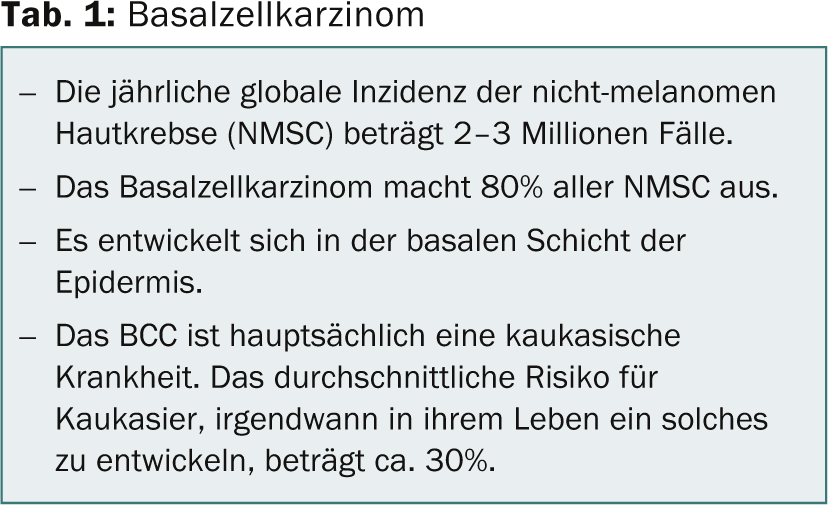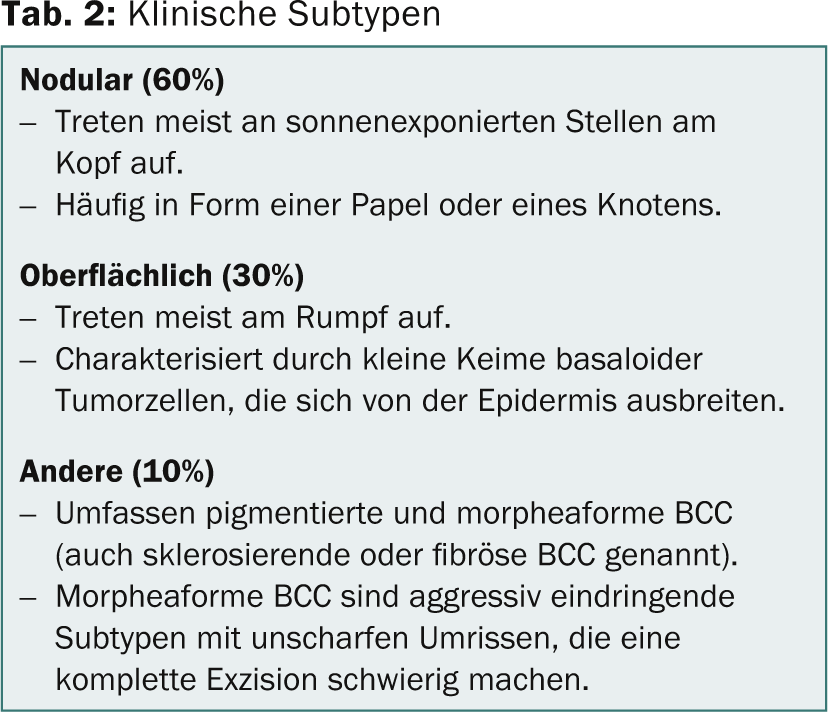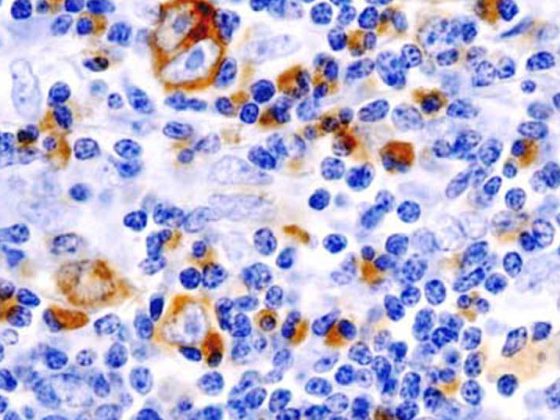New avenues in the treatment of basal cell carcinoma (BCC) are being intensively discussed by current researchers. In particular, the functioning and inhibition of the Hedgehog signaling pathway offers an interesting field for understanding tumorigenesis and thus its suppression. This is all the more important because BCC is a very common form of cancer worldwide.
Basal cell carcinoma (BCC) is the most commonly diagnosed malignant tumor in the world (Table 1). According to Prof. Rainer Kunstfeld, MD, Vienna, UV radiation is one of the most important causes of BCC because it leads to cumulative damage to DNA and gene mutations. The majority of BCC occurs on the head and neck. Epidemiologic data indicate that incidence is increasing significantly worldwide and varies widely geographically. Australia is particularly hard hit, with an annual rate of 1-2%.
There are several clinical subtypes (Table 2). In each case, the degree of severity must be considered: Locally advanced forms of BCC occur in only a few patients, but they include lesions that cannot be addressed surgically or only by surgery associated with disfigurement. A BCC that develops distant metastases in bones, lungs or liver or occurs with involvement of the lymph nodes is also rare, but then associated with a prognosis that is all the worse: The average survives only 8-14 months.
In hereditary Gorlin-Goltz syndrome, multiple BCCs form, predominantly visible on the face. Treatment can be done only by frequent surgery and cryotherapy.


Femur fracture due to metastases
According to Prof. Kunstfeld, an interesting case occurred in a 74-year-old woman who fell at home and broke her left femur. During the subsequent immediate surgery, the doctor noticed suspicious tissue in the bone and surrounding area. Samples were taken and examined microscopically. RESULT: The patient suffered the fracture because of metastases from a BCC, and scintigraphy showed multiple lesions in the femur, spine, and left shoulder.
Inhibition of the Hedgehog signaling pathway
Prof. Dr. med. Dirk Schadendorf, Essen, Germany, presented the experience to date with Hedgehog pathway inhibition in BCC. (Tab. 3). A 2009 phase I clinical trial of the safety and pharmacokinetics of GDC-0449 (vismodegib), an orally active small molecule that targets the Hedgehog pathway, points to its anti-tumor activity in locally advanced or metastatic BCC [1]. The drug was well tolerated, with no dose-limiting toxicities. Nineteen of 33 patients had regressed tumors. For the phase II evaluation [2], a single dose of 150 mg/d was chosen. The results confirmed those of the previous study and led to approval by the Food and Drug Administration (FDA). The drug is also on the market in Switzerland.
Another recent phase II study [3] also demonstrated the effect of vismodegib for patients with Gorlin-Goltz syndrome. The formation of new BCC was inhibited. However, more than half of the patients discontinued participation due to side effects.
“Overall, inhibition of the Hedgehog pathway represents a new treatment pathway for patients with advanced BCC. It also reduces the number of new and the size of existing BCC in those with Gorlin-Goltz syndrome,” Prof. Schadendorf concluded.
New ways of targeted therapy
Prof. Reinhard Dummer, MD, of the University Hospital Zurich, reported on targeted treatment in BCC. Among other things, he emphasized the dual role of primary cilia, cell processes that mediate in the Hedgehog signaling pathway but can also suppress it. The human BCC is often ciliated. Thus, primary cilia have a direct influence on tumorigenesis. Mouse models [4] show that ciliary excision strongly inhibited the growth of BCC-like tumors induced by an activated form of Smoothened (Smo), whereas it accelerated the progression of those induced by an activated GLI2 protein.
“The efficacy of anticancer drugs targeting the Hedgehog pathway will be based on whether activation of this pathway is dependent or independent of primary cilia. Some inhibitors may be ineffective if primary cilia are absent in cancer cells [5],” Prof. Dummer summarized.
Source: “What’s new for basal cell carcinoma?”, Workshop at the 8th World Congress of Melanoma, July 17-20, 2013, Hamburg, Germany.
Literature:
- Von Hoff DD, et al: Inhibition of the Hedgehog Pathway in Advanced Basal-Cell Carcinoma. N Engl J Med 2009; 361: 1164-1172 DOI: 10.1056/NEJMoa0905360.
- Sekulic A, et al: Efficacy and Safety of Vismodegib in Advanced Basal-Cell Carcinoma. N Engl J Med 2012; 366: 2171-2179 DOI: 10.1056/NEJMoa1113713.
- Tang JY, et al. Inhibiting the Hedgehog Pathway in Patients with the Basal-Cell Nevus Syndrome. N Engl J Med 2012; 366: 2180-2188 DOI: 10.1056/NEJMoa1113538.
- Wong SY, et al: Primary cilia can both mediate and suppress Hedgehog pathway-dependent tumorigenesis. Nat Med 2009 September; 15(9): 1055-1061.
- Hassounah NB, et al: Molecular pathways: the role of primary cilia in cancer progression and therapeutics with a focus on Hedgehog signaling. Clin Cancer Res 2012; 18(9): 2429-35 DOI: 10.1158/1078-0432.CCR-11-0755. epub 2012 Mar 13.
InFo Oncology & Hematology 2013; 1(1): 44-45.











